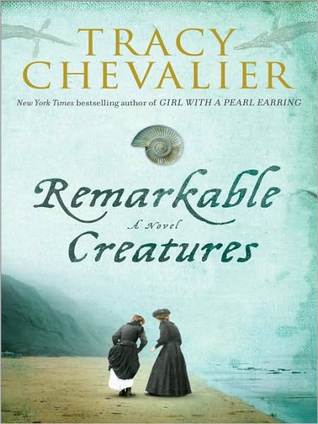
Remarkable Creatures
کتاب های مرتبط
- اطلاعات
- نقد و بررسی
- دیدگاه کاربران
نقد و بررسی

September 28, 2009
Chevalier's newest is a flat historical whose familiar themes of gender inequality, class warfare and social power often overwhelm the story. Tart-tongued spinster Elizabeth Philpot meets young Mary Anning after moving from London to the coastal town of Lyme Regis. The two quickly form an unlikely friendship based on their mutual interest in finding fossils, which provides the central narrative as working-class Mary emerges from childhood to become a famous fossil hunter, with her friend and protector Elizabeth to defend her against the men who try to take credit for Mary's finds. Their friendship, however, is tested when Colonel Birch comes to Lyme to ask for Mary's help in hunting fossils and the two spinsters compete for his attention. While Chevalier's exploration of the plight of Victorian-era women is admirable, Elizabeth's fixation on her status as an unmarried woman living in a gossipy small town becomes monotonous, and Chevalier slows the story by dryly explaining the relative importance of different fossils. Chevalier's attempt to imagine the lives of these real historical figures makes them seem less remarkable than they are.

October 15, 2009
More fact-based historical fiction from Chevalier (Burning Bright, 2007, etc.): the vivid, rewarding tale of 19th-century fossil hunter Mary Anning.
Before Darwin's findings rocked the world, a small group of scientists were already—in some people's view, blasphemously—questioning the age of the Earth, the finality of God's creation and the possibility of an ancient world before man. In young Mary's case, however, finding fossils quite simply keeps her family from the workhouse. Raised in Lyme Regis on the English coast, she's trained by her father to spot what they call"curies" (curiosities): ammonites, belemnites, fossilized fish on the beach and embedded in cliffs that the family sells to tourists during the summer. Paired with Mary's narrative is that of Elizabeth Philpot, dispatched with her two sisters from London to the coast when their brother marries. Elizabeth (also a historical figure, like most of the characters) is impressed by Mary's sharp eye and considerable knowledge about fossils, remarkable qualities for an illiterate girl. Plain, outspoken and without the substantial income that would make those failings palatable, Elizabeth is resigned to spinsterhood, but Lyme offers outlets for her curiosity about the natural world, as well as the satisfaction of watching a burgeoning science develop. She forms an unlikely alliance with Mary as they comb the beach together, and when Mary's discoveries of several complete dinosaur fossils (including a pterodactyl) bring the scientific community to her door, Elizabeth acts as spokeswoman for her less confident friend. Chevalier handles the science with a deft hand, but her real subject is two women barred from the professional community of men who are also denied access to the more acceptable roles of wife and mother. (Mary's"unwholesome" pursuits and working-class background put her beyond the pale of proper society.). Yet somehow Mary and Elizabeth thrive, and the novel glories in their substantial achievements against considerable odds.
Shines a light on women usually excluded from history—and on the simple pleasures of friendship.
(COPYRIGHT (2009) KIRKUS REVIEWS/NIELSEN BUSINESS MEDIA, INC. ALL RIGHTS RESERVED.)

Starred review from November 1, 2009
In early 1800s England, unmarried women of the upper classes were often relegated to the fringes of society, where they could find a polite way to spend their days; those of the lower classes had even fewer options. This work, based on a true story, portrays two women from these diverse backgrounds who share a fascination with fossils. Mary Anning is an impoverished girl with a gift for finding prehistoric skeletons along the coast, which also interest genteel spinster Elizabeth Philpot. She recognizes Mary's talent as she also understands the enormous implications of the specimens uncovered, for this was before Darwin, when the concept of extinction was unknown, and it was blasphemous to consider that some of God's creatures may have been flawed. Over time, both women strive for scientific credibility, love, and financial stability, with varying degrees of success. VERDICT Superbly creating a unique setting, as she did in "The Girl with a Pearl Earring", Chevalier captures the atmosphere of a chilly, blustery coast and an oppressive social hierarchy in real Dickensian fashion. Readers of historical fiction will enjoy this fascinating tale of rustic paleontology. [See Prepub Alert, "LJ" 9/1/09.]Susanne Wells, P.L. of Cincinnati & Hamilton Cty.
Copyright 2009 Library Journal, LLC Used with permission.

October 15, 2009
As she did with Vermeers painting in The Girl with the Pearl Earring (2000) and with tapestry making in The Lady and the Unicorn (2004), Chevalier again immerses readers in a world far removed from their own. The remarkable creatures of the title are both the fossils found on the rocky beaches of Lyme Regis in England during the 1800s and the fossil hunters, working-class Mary Anning and middle-class spinster Elizabeth Philpot, a London exile. Born with a keen eye and a love for the curies she so adeptly spots on the beach, Mary relies on her ability to help support the family, selling her treasures to tourists and townsfolk. Elizabeth Philpot, relegated, along with her two sisters, to Lyme Regis by her brother, who has recently married, brings an educated eye to Marys finds, schooling her on the scientific names and anatomy of the fossils. When Mary finds an unusual skeleton unlike anything that has ever been discovered before, her work is brought to the attention of the scientific community, but what should be a heady achievement becomes a struggle for recognition from the male-dominated profession, one that ultimately pits the two women against each other. A perfect choice for book clubs and for Austen fans, this many-faceted novel, based on a true story, has a lot to say about womens friendships and class and social prejudice.(Reprinted with permission of Booklist, copyright 2009, American Library Association.)

























دیدگاه کاربران